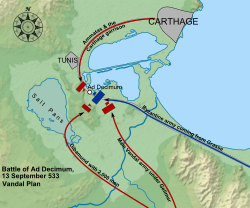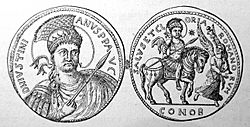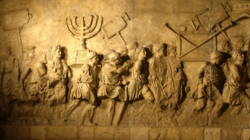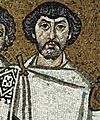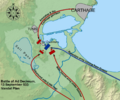Vandalic War facts for kids
Quick facts for kids Vandalic War |
|||||||||
|---|---|---|---|---|---|---|---|---|---|
| Part of Justinian's wars of Reconquest | |||||||||
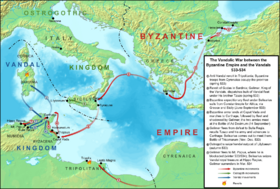 Campaign map of the war |
|||||||||
|
|||||||||
| Belligerents | |||||||||
| Eastern Roman Empire | Vandalic Kingdom | ||||||||
| Commanders and leaders | |||||||||
| Belisarius Calonymus |
Gelimer | ||||||||
| Strength | |||||||||
| 10,000 infantry 5,000–7,000 cavalry |
c. 20,000–25,000 or c. 30,000–40,000, mostly cavalry | ||||||||
The Vandalic War was a big fight in North Africa. It happened between the Byzantine Empire and the Vandal Kingdom of Carthage from 533 to 534 AD. This war was the first step in Emperor Justinian I's plan to take back parts of the old Western Roman Empire.
The Vandals were a Germanic tribe who took over Roman North Africa in the early 400s. They created their own kingdom there. Their king, Geiseric, used his navy to attack ships across the Mediterranean Sea. He even attacked Rome in 455 AD. He also defeated a Roman invasion in 468 AD. After Geiseric died in 477 AD, the Vandals and the Eastern Roman Empire got along better. But problems sometimes came up. This was because the Vandals followed a different Christian belief called Arianism. They often treated the local people, who were Nicene Christians, badly.
In 530 AD, a new king named Gelimer took over in Carthage. He removed the old king, Hilderic, who was friendly with the Romans. Emperor Justinian used this as a reason to get involved. After making peace with Sassanid Persia in 532 AD, Justinian got ready for war. He sent his best general, Belisarius, to lead the army. Belisarius's secretary, Procopius, wrote down the main story of the war. Justinian also used the fact that there were rebellions in Vandal areas like Sardinia and Tripolitania. These rebellions made Gelimer send many of his ships and soldiers, led by his brother Tzazon, to Sardinia. This weakened the Vandal defenses in Africa.
The Roman army sailed from Constantinople in June 533 AD. They landed in Africa at Caputvada in September. Gelimer was completely surprised. He quickly gathered his army and met the Romans at the Battle of Ad Decimum near Carthage on September 13. Gelimer's plan to surround the Roman army almost worked. But Belisarius managed to make the Vandal army run away. The Romans then took over Carthage. Gelimer went to Bulla Regia and gathered his remaining forces. This included Tzazon's army, which had returned from Sardinia. In December, Gelimer attacked Carthage again. He met the Romans at the Battle of Tricamarum. The Romans won this battle, and Tzazon was killed. Gelimer ran away to a mountain fort. He was trapped there until he gave up in the spring.
Belisarius went back to Constantinople with the Vandal king's treasure and Gelimer as a prisoner. He celebrated a victory parade. Africa officially became part of the Roman Empire again. But Roman control didn't go much beyond the old Vandal kingdom. The Mauri tribes in the inner lands didn't want Roman rule. They soon started to rebel. The new Roman province had many wars with the Mauri and army rebellions. Peace finally came in 548 AD, and Roman rule was firmly set up.
Contents
How the Vandal Kingdom Began
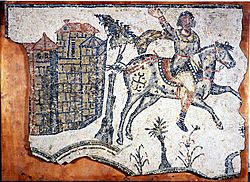
The Western Roman Empire was slowly falling apart in the early 400s. During this time, a Germanic tribe called the Vandals moved into Spain. In 429 AD, the Roman governor of Africa, Bonifacius, asked the Vandal King Geiseric for help. Bonifacius was rebelling against the Roman emperor Valentinian III. So, in May 429, Geiseric crossed into Africa with his whole people, about 80,000 in total.
But Geiseric's Vandals had their own plans. They wanted to conquer the African provinces for themselves. In 435 AD, the Western Roman court recognized their control over some areas. But this was only for a short time. Fighting started again, and in October 439, the Vandals captured Carthage, the capital of Africa. In 442, a new agreement was made. The Vandals received the rich provinces of Zeugitana and Byzacena. They now owned these lands, instead of just being allies of the Empire. This was the start of the Vandal Kingdom. The Vandals made Carthage their capital and settled around it.
The Vandals now controlled the important grain trade with Italy. They also launched raids along the Mediterranean coast. These raids reached as far as Greece. In 455 AD, they even attacked Rome itself. This attack supposedly lasted for two weeks. After the death of Emperor Valentinian in 455, Geiseric took control of more areas. He gained Sardinia, Corsica, and the Balearic Islands.
The Romans tried several times to fight back against the Vandals. But they failed each time. In 468 AD, Geiseric defeated a huge Roman attack. This attack was from both the western and eastern Roman empires. After this big loss, and more Vandal raids, the Eastern Roman emperor Zeno made a "forever peace" with Geiseric in 474/476 AD.
Roman and Vandal Relations Before the War
The Vandal state was different from other Germanic kingdoms. Instead of keeping the Roman way of life, they completely changed it. Other kings still respected the Roman emperors. But the Vandal kings acted as fully independent rulers. The Vandals also kept their own language and clothes. This showed they were the ruling group in the kingdom. Also, the Vandals were Arian Christians. They often treated the local people, who were Chalcedonian Christians, badly. This was especially true during the reigns of Huneric (477–484) and Gunthamund (484–496).
The emperors in Constantinople protested this treatment. But the peace lasted for almost sixty years. Relations were often friendly. This was especially true between Emperor Anastasius I (491–518) and Thrasamund (496–523). Thrasamund mostly stopped the persecutions.
In 523 AD, Hilderic (523–530) became king in Carthage. Hilderic was related to the Roman emperor Valentinian III. He made his kingdom closer to the Roman Empire. According to Procopius, Hilderic was a peaceful and friendly person. He stopped treating the Chalcedonian Christians badly. He also exchanged gifts with Justinian I (527–565). Justinian hoped this friendship would lead to the Vandal state joining his empire peacefully.
However, Hilderic's pro-Roman ideas caused problems with the Vandal nobles. He also lost a battle against the Mauri in Byzacena. In 530 AD, his cousin, Gelimer (530–534), overthrew him and put him in prison. Justinian used this as an excuse. He demanded that Hilderic be put back on the throne. Gelimer refused. Justinian then demanded Hilderic's release to Constantinople, threatening war. Gelimer didn't want to give Justinian a rival king. He probably expected war anyway. So he refused, saying it was a Vandal internal matter.
Justinian now had his reason for war. After making peace with Sassanid Persia in 532, he started getting an army ready. Procopius wrote that many people in Constantinople were worried. They remembered the disaster of the 468 AD invasion. Financial officials didn't like the cost. The army was tired from the war with Persia. They also feared the Vandal navy. Only the Church supported the war. Victims of new persecutions from Africa arrived, which helped. A powerful minister, John the Cappadocian, spoke against the plan. But Justinian ignored him and continued preparing.
Revolts and Diplomatic Moves
Soon after Gelimer took power, his position became weaker. He treated his political enemies among the Vandal nobles badly. He took their property and killed many of them. These actions made many people doubt his right to rule. This led to two rebellions in far-off Vandal provinces.
- In Sardinia, the local governor, Godas, declared himself an independent ruler.
- Soon after, in Tripolitania, the local people, led by Pudentius, rebelled against Vandal rule.
These rebellions happened just before the Roman army set sail. Both Godas and Pudentius immediately asked Justinian for help. This suggests that Justinian might have helped plan these uprisings.
Gelimer reacted to Godas's rebellion by sending most of his fleet. He sent 120 of his best ships and 5,000 men. His brother Tzazon led them to Sardinia to stop the revolt. This decision was very important for the war. It removed the Vandal navy, which was the main obstacle to a Roman landing in Africa. It also took away a large part of his army. Gelimer decided to ignore the revolt in Tripolitania for a while. It was less of a threat and further away. He also didn't have enough soldiers. He had to wait for Tzazon to return from Sardinia before doing more.
At the same time, both sides tried to find allies. Gelimer talked to the Visigoth king Theudis about an alliance. Justinian got the Ostrogothic Kingdom in Italy to stay neutral and help him. The Ostrogoths had problems with the Vandals. This was because of how they treated the Ostrogoth princess Amalafrida. She was the wife of Thrasamund. The Ostrogoth court agreed to let the Roman fleet use the harbor of Syracuse in Sicily. They also set up a market there for the Roman troops to get supplies.
The Armies Ready for War

Justinian chose Belisarius to lead the expedition. Belisarius was one of his most trusted and skilled generals. He had recently done well against the Persians and stopped the Nika riots. Belisarius was also a good choice for other reasons. He spoke Latin, which was important in Africa. He also cared about the local people and kept his soldiers in line. This helped him gain support from the Latin-speaking Africans. Belisarius was joined by his wife, Antonina, and his secretary, Procopius.
According to Procopius, the Roman army had 10,000 foot soldiers. Some were from the main army, and some were allied troops. There were also 5,000 cavalry (horse soldiers). Belisarius also had 1,500–2,000 of his own special guards, called bucellarii. These were elite soldiers. In addition, there were 600 Huns and 400 Heruls, who were mounted archers. The army had many experienced officers. The chief of staff was the eunuch Solomon. Archelaus was in charge of supplies. Rufinus the Thracian and Aïgan the Hun led the cavalry.
The whole force traveled on 500 ships. These ships had 30,000 sailors. Ninety-two fast warships called dromons protected them. Many historians thought the Roman army was very small for such a big task. This was especially true given how strong the Vandals were. But some historians now believe Belisarius's army was a "large, well-balanced force." It had many high-quality, reliable troops.
On the Vandal side, the numbers are less clear. The Vandal army was not a professional army like the Roman one. It included every Vandal man who could fight. Estimates of their numbers range from 30,000–40,000 men. This is out of a total Vandal population of about 200,000 people. Other estimates are as low as 20,000–25,000 men.
Despite their fighting fame, the Vandals had become less warlike. They lived a luxurious life in rich Africa. Also, their fighting style was not good against Belisarius's experienced soldiers. The Vandal army was only made of cavalry. They had light armor and only fought hand-to-hand. They didn't use bows or javelins at all. This was very different from Belisarius's heavily armored horsemen, called cataphracts, and his horse archers.
The Vandals were also weaker because their Roman subjects didn't like them. Some Vandals were still loyal to the old king Hilderic. The Mauri tribes were also watching. They were ready to join whoever won and take the spoils.
The War Begins
Belisarius Sails to Africa
The Roman fleet set sail around June 21, 533 AD. Justinian and the Patriarch of Constantinople were there to see them off. The journey started slowly. The fleet waited for horses at Heraclea Perinthus for five days. Then they waited at Abydus for four days because there was no wind. The fleet left the Dardanelles on July 1. They crossed the Aegean Sea to the port of Methone. Here, the last groups of soldiers joined them. Belisarius used the time there to train his troops. He also helped the different groups get to know each other.
However, at Methone, 500 men died from dysentery. This was caused by moldy bread. Procopius said that John the Cappadocian was responsible. He had cut costs by baking the bread only once, so it went bad. Justinian was told, but John was not punished. Belisarius took steps to fix the problem, and the army soon got better.
From Methone, the fleet sailed to Zacynthus. From there, they crossed to Italy. The crossing took longer than expected because there was no wind. The army suffered from a lack of fresh water. Their supplies had gone bad. Finally, the fleet reached Catania in Sicily. Belisarius sent Procopius ahead to Syracuse. Procopius was to gather information about the Vandals. By chance, Procopius met a merchant friend there. The merchant's servant had just arrived from Carthage. The servant told Procopius that the Vandals didn't know about Belisarius's sailing. He also said that Gelimer had just sent Tzazon's army to Sardinia. Gelimer himself was away from Carthage, in a small town called Hermione.
Procopius quickly told Belisarius. Belisarius immediately ordered the army back onto the ships. They sailed for the African coast. After passing Malta, they reached Cape Caputvada. This was on the eastern shore of modern Tunisia. It was about 162 Roman miles (240 km) south of Carthage.
March to Carthage and the Battle of Ad Decimum
When the Roman fleet reached Africa, Belisarius held a meeting on his ship. Many officers wanted to attack Carthage right away. Carthage was the only fortified city in the Vandal kingdom. The walls of other cities had been torn down to prevent rebellions. But Belisarius remembered the failed invasion of 468 AD. He was also careful about meeting the Vandal fleet. So, he spoke against an immediate attack. The army landed and built a strong camp for the night.
Belisarius knew that his success depended on getting the local people's support. They still felt Roman. He presented himself as a liberator. The next day, some of his men stole fruit from an orchard. He punished them severely. He then gathered the army and told them to be disciplined. He warned them not to harm the local people. If they did, the locals might stop supporting the Romans and join the Vandals. Belisarius's words worked. Procopius wrote that "the soldiers behaved with moderation." They didn't cause trouble. Belisarius showed great kindness. He won over the Libyans completely. After that, he traveled "as if in his own land."
The Roman army then marched north along the coast. Three hundred horsemen, led by John the Armenian, rode ahead. They were about 3 miles (4.5 km) in front of the main army. The 600 Huns protected the army's left side. Belisarius himself, with his special guards, marched at the back. He wanted to guard against any attack from Gelimer, who was known to be nearby. The fleet followed the army, sailing along the coast. The first town they found was Syllectum. A group of soldiers led by Boriades captured it by a trick.
Belisarius tried to cause problems among the Vandals. He gave a captured Vandal messenger a letter from Justinian. The letter was for the Vandal nobles. In it, the emperor claimed to be fighting for the rightful king Hilderic against Gelimer. But the messenger was too scared to deliver the letter, so this plan failed.
Gelimer, meanwhile, learned that the Romans had arrived. He immediately told his brother Ammatas in Carthage to gather the Vandal forces. He also ordered Ammatas to kill Hilderic and his relatives. His secretary Bonifatius was told to load the royal treasure onto a ship. He was to sail to Spain if the Romans won. Gelimer had sent his best troops with Tzazon. So, he only had enough men to follow the Roman army. He planned a big battle near Carthage, at a place called Ad Decimum. He had ordered Ammatas to bring his forces there. The Romans marched through Thapsus, Leptis Parva, and Hadrumetum to Grasse. There, they had their first small fight with Gelimer's scouts. Both sides went back to their camps. From Grasse, Belisarius turned his army west. He cut across the Cape Bon peninsula. This was the most dangerous part of the route to Carthage. The fleet was out of sight.
On the morning of September 13, the Roman army reached Ad Decimum. This was the tenth day of their march from Caputvada. Gelimer planned to ambush and surround them. He would use a force under his brother Ammatas to block their advance. Two thousand men under his nephew Gibamund would attack their left side. Gelimer himself, with the main army, would attack from the rear. This would completely destroy the Roman army.
But the three Vandal forces didn't attack at the same time. Ammatas arrived early. He was killed while trying to scout with a small group. Gibamund's force was stopped by the Hunnic flank guard and completely destroyed. Gelimer didn't know any of this. He marched up with the main army and defeated the Roman advance forces at Ad Decimum. He might have won, but then he found his dead brother's body. He seemed to forget all about the battle. This gave Belisarius time to gather his troops. Belisarius brought up his main cavalry force and defeated the disorganized Vandals. Gelimer and the rest of his forces fled west into Numidia. The Battle of Ad Decimum was a huge Roman victory. Carthage was now open and undefended for Belisarius.
Belisarius Enters Carthage and Gelimer's Counterattack
It was nightfall when John the Armenian and the 600 Huns rejoined Belisarius's army. Only then did Belisarius realize how big his victory was. The cavalry spent the night on the battlefield. The next morning, the infantry caught up. The whole army marched to Carthage. They arrived as night was falling. The people of Carthage had opened the gates and lit up the city to celebrate. But Belisarius was careful. He feared an ambush in the dark. He also wanted to keep his soldiers under control. So, he didn't enter the city and camped outside.
Meanwhile, the fleet had sailed around Cape Bon. After hearing about the Roman victory, they anchored near the city. Ignoring Belisarius's orders, Admiral Calonymus and his men looted a nearby merchant settlement.
On the morning of September 15, Belisarius lined up his army for battle outside the city walls. But no enemy appeared. So, he led his army into the city. He again told his troops to be disciplined. The Roman army received a warm welcome from the people. They were impressed by the soldiers' good behavior. Belisarius took over the royal palace. He sat on the king's throne and ate the dinner Gelimer had ordered for his own victory. The fleet entered the Lake of Tunis. The army was housed throughout the city. The remaining Vandals were rounded up and guarded. This was to stop them from causing trouble. Belisarius sent Solomon to Constantinople with news of the victory. But he expected Gelimer to return soon. So, he quickly repaired the city's ruined walls. He made it ready to withstand a siege.

In the following weeks, Belisarius stayed in Carthage. He made the walls stronger. Gelimer set up his remaining army at Bulla Regia. He gave out money to keep the locals loyal. He also sent messages to Tzazon and his men in Sardinia. They had successfully put down the rebellion there and killed Godas. While waiting for Tzazon, Gelimer's army grew. More soldiers who had fled the Battle of Ad Decimum joined him. A group of his Mauri allies also arrived.
However, most of the Mauri tribes in Numidia and Byzacena sent messages to Belisarius. They promised loyalty to the Empire. Some even offered hostages. They asked for the special items traditionally given to them by the emperor. These included a silver staff, a silver crown, a white cloak, a white tunic, and a gilded boot. Justinian had given Belisarius these items. So, Belisarius sent them along with money. But it was clear that neither side could fully trust the Mauri. Their loyalty depended on who was winning the war.
During this time, messengers from Tzazon sailed into Carthage. They were sent to announce his victory in Sardinia. They didn't know the city had fallen and were captured. Soon after, Gelimer's messengers to Theudis were also captured. They had reached Spain after news of Roman victories arrived there. So, they failed to get an alliance. Belisarius also got more help from the Roman general Cyril. Cyril had sailed to Sardinia but found it back in Vandal hands.
As soon as Tzazon got his brother's message, he left Sardinia. He landed in Africa and joined Gelimer at Bulla. Gelimer now decided to attack Carthage. He cut the aqueduct that supplied water to the city. He also tried to stop food from reaching the city. Gelimer sent agents into the city. They tried to make the people and the Roman army disloyal. Belisarius was aware of possible betrayal. He made an example by punishing a citizen of Carthage who planned to join the Vandals.
The biggest danger of betrayal came from the Huns. They were unhappy because they had been brought to Africa against their will. They feared being left there as a garrison. Vandal agents had already contacted them. But Belisarius managed to keep their loyalty. He promised them rich rewards and a return home after the final victory. However, their loyalty remained doubtful. Like the Mauri, the Huns probably waited to see who would win.
The Battle of Tricamarum and Gelimer's Surrender
Belisarius made sure the people and army were loyal. He also finished repairing the walls. Then he decided to fight Gelimer. In mid-December, he marched out of Carthage. He headed towards the Vandal camp at Tricamarum, about 28 km away. Like at Ad Decimum, the Roman cavalry went ahead of the infantry. The battle that followed, the Battle of Tricamarum, was only fought by cavalry. Belisarius's army was much smaller in number. Both armies kept their least trustworthy groups—the Mauri and Huns—in reserve.
John the Armenian was very important for the Romans. Tzazon was important for the Vandals. John led repeated attacks on the Vandal center. This ended with Tzazon's death. Then, the Romans attacked everywhere. The Vandal army fell apart. They retreated to their camp. Gelimer saw that all was lost. He fled with a few followers into the wild parts of Numidia. The remaining Vandals gave up. They left their camp to be looted by the Romans.
Like the Battle of Ad Decimum, Belisarius again failed to keep his forces together. He had to fight with fewer soldiers. After the battle, his army spread out, looting carelessly. This made them open to a Vandal counter-attack. This showed the poor discipline in the Roman army. It also showed the command problems Belisarius faced. Some historians say the expedition might have ended differently if Belisarius had faced a more skilled commander. Procopius himself was amazed by the outcome of the war. He saw it as a stroke of luck, not a great strategy.
A Roman group led by John the Armenian chased the fleeing Vandal king for five days and nights. They were almost upon him when John was killed in an accident. The Romans stopped to mourn their leader. This allowed Gelimer to escape. He went first to Hippo Regius. From there, he went to the city of Medeus on Mount Papua. He could trust the Mauri people there. Belisarius sent 400 men under the Herul Pharas to trap him there.
Belisarius himself went to Hippo Regius. The Vandals who had fled to various safe places surrendered to the Roman general. He promised they would be treated well and sent to Constantinople in the spring. Belisarius was also lucky to get back the Vandal royal treasure. It had been loaded onto a ship at Hippo. Bonifatius, Gelimer's secretary, was supposed to sail with it to Spain. Gelimer would follow later. But bad winds kept the ship in the harbor. In the end, Bonifatius gave it to the Romans for his own safety. He also got a lot of the treasure, if Procopius is to be believed.
Belisarius also started to take control of the Vandal kingdom's other provinces and outposts. Cyril was sent to Sardinia and Corsica with Tzazon's head as proof of his victory. John was sent to Caesarea on the coast of Mauretania Caesariensis. Another John was sent to the fortresses of Septem and Gadira. These controlled the Straits of Gibraltar. Apollinarius took control of the Balearic Islands. Help was also sent to the people in Tripolitania. They had been attacked by local Mauri tribes. Belisarius also demanded the port of Lilybaeum in western Sicily back from the Ostrogoths. They had captured it during the war. It had been part of the Vandal kingdom. Letters were exchanged between Justinian and the Ostrogoth court. This led Justinian into their problems. It resulted in the Roman invasion of Italy a year later.
Meanwhile, Gelimer remained trapped by Pharas at the mountain fort of Medeus. But as the blockade continued through the winter, Pharas grew impatient. He attacked the mountain fort. But he was pushed back and lost a quarter of his men. This was a success for Gelimer. But it didn't change his hopeless situation. He and his followers remained tightly trapped. They began to suffer from lack of food. Pharas sent him messages, asking him to surrender. He told Gelimer to spare his followers the misery. But it wasn't until March that the Vandal king agreed to surrender. He received promises for his safety. Gelimer was then taken to Carthage.
What Happened After the War
Belisarius's Victory Parade
Belisarius didn't stay long in Africa to make his success permanent. Some officers in his army, hoping to get ahead, sent messages to Justinian. They claimed Belisarius wanted to create his own kingdom in Africa. Justinian then gave his general two choices to test his intentions. He could return to Constantinople or stay in Africa. Belisarius had captured one of the messengers and knew about the false claims. So, he chose to return.
He left Africa in the summer. With him were Gelimer, many captured Vandals, and the Vandal treasure. The treasure included many items stolen from Rome 80 years earlier. This included the imperial symbols and the menorah from the Second Temple. In Constantinople, Belisarius was given the honor of celebrating a victory parade. This was the first triumph in Constantinople since it was founded. It was also the first given to a private citizen in over 550 years. Procopius described it:
And there was booty—first of all, whatever articles are wont to be set apart for the royal service—thrones of gold and carriages in which it is customary for a king's consort to ride, and much jewelry made of precious stones, and golden drinking cups, and all the other things which are useful for the royal table. And there was also silver weighing many thousands of talents and all the royal treasure amounting to an exceedingly great sum, and among these were the treasures of the Jews, which Titus, the son of Vespasian, together with certain others, had brought to Rome after the capture of Jerusalem. [...] And there were slaves in the triumph, among whom was Gelimer himself, wearing some sort of a purple garment upon his shoulders, and all his family, and as many of the Vandals as were very tall and fair of body. And when Gelimer reached the hippodrome and saw the emperor sitting upon a lofty seat and the people standing on either side and realized as he looked about in what an evil plight he was, he neither wept nor cried out, but ceased not saying over in the words of the Hebrew scripture: "Vanity of vanities, all is vanity." And when he came before the emperor's seat, they stripped off the purple garment, and compelled him to fall prone on the ground and do obeisance to the Emperor Justinian. This also Belisarius did, as being a suppliant of the emperor along with him.
—Procopius, The Vandalic War, II.9
Gelimer was given a large estate in Galatia. He would have been given a high rank, called patrician, if he had agreed to give up his Arian Christian faith. Belisarius was also named a regular Roman consul for the year 535. This allowed him to celebrate a second victory parade. He was carried through the streets on his special consular chair. Vandal warriors carried him. He gave out gifts to the people from his share of the war treasure.
Roman Rule Returns to Africa
Right after the Battle of Tricamarum, Justinian quickly announced that Africa was back under Roman control. He said that God had given Africa and its provinces back to them. He also said that the imperial symbols, taken from Rome when it was captured, were now returned.
The emperor wanted to bring the province back to its old size and wealth. He wanted to "wipe out all traces of the Vandal conquest," as if it had never happened. To do this, Vandals were not allowed to hold office or own property. Property was returned to its original owners. Most Vandal men became slaves. The victorious Roman soldiers took their wives. The Chalcedonian Church was given back its old position. The Arian Church lost its property and was persecuted. Because of these actions, the Vandal population became smaller and weaker. They slowly disappeared, becoming part of the larger local population.
By April 534, even before Gelimer surrendered, the old Roman provincial system was brought back. A praetorian prefect was put in charge. Belisarius's army stayed behind to guard the new province. A magister militum was the overall commander. Several regional duces were also in charge. A large building project also started. This included building city walls and smaller forts to protect the countryside. Their remains are still important historical sites in the region.
But despite Justinian's plans, Roman control over Africa was not yet safe. During his campaign, Belisarius had secured most of the provinces of Byzacena, Zeugitana, and Tripolitania. Further west, Roman control was only a series of strongholds along the coast. Most of the inland areas of Numidia and Mauretania remained under the control of local Mauri tribes. This had also been the case under the Vandal kings. The Mauri at first accepted the Emperor's rule. They gave hostages to the Roman authorities. But they soon became restless and rebelled.
The first Roman governor, Solomon, was Belisarius's former chief of staff. He was both the military commander and the prefect. He managed to win battles against the Mauri. He also strengthened Roman rule in Africa. But his work was stopped by a big army rebellion in 536. The rebellion was eventually put down by Germanus, a cousin of Justinian. Solomon returned in 539. However, he died in the Battle of Cillium in 544. He was fighting against the united Mauri tribes. Roman Africa was again in danger. It was not until 548 that the Mauri tribes' resistance was finally broken by the skilled general John Troglita.
Images for kids
Sources
Secondary
See also
 In Spanish: Guerra vándala para niños
In Spanish: Guerra vándala para niños



